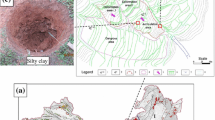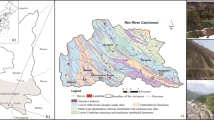Abstract
Post-failure field investigation, instrumentation, monitoring, and numerical simulation were performed to give insights into the failure mechanism of a 13-h-delayed rainfall-induced landslide. A conceptual hydrological model was postulated based on the findings obtained from the investigation works. The results showed that subsurface flow was recharged by intense and prolonged rainfall through outcrops of fissured bedrock. The recharged water was mounded in the moderately weathered granite layer and caused an increase in hydraulic head. The groundwater seeped gradually upward into the overlying fill layer even after the rain has ceased, and eventually triggered the landslide when the water table was raised to a critical state. As most of the existing hydrologic-slope stability models were developed on the basis of soil-impermeable bedrock model, this could result in great discrepancies between the simulated results and the real hydrological responses of the slope. The findings from the present study highlighted the importance of considering subsurface flow and hydro-geological features in assessing the mechanism of rainfall-induced landslide.
















Similar content being viewed by others
References
Aleotti P (2004) A warning system for rainfall-induced shallow failures. Eng Geol 73:247–265
Au SWC (1998) Rain-induced slope instability in Hong Kong. Eng Geol 51:1–36
Cho SE, Lee SR (2002) Evaluation of surficial stability for homogeneous slopes considering rainfall characteristics. J Geotech Geoenviron Eng Geol 128:756–763
Collins BD, Znidarcic D (2004) Stability analyses of rainfall induced landslides. J Geotech Geoenviron Eng ASCE 130(4):362–372
Crosta GB, Frattini P (2003) Distributed modeling of shallow landslides triggered by intense rainfall. Nat Hazards Earth Syst Sci 3:81–93
Dai FC, Lee CF, Wang SJ (1999) Analysis of rainstorm-induced slide-debris flows on natural terrain of Lantau Island, Hong Kong. Eng Geol 51:279–290
Dixon N, Bromhead EN (1999) Depth-dependent permeability in London Clay measured using standpipe piezometer equilibration data. Geotechnique 49(5):651–660
Ebel BA, Loague K, Dietrich WE et al (2007a) Near-surface hydrologic response for a steep, unchanneled catchment near Coos Bay, Oregon: 1. Sprinkling experiments. Am J Sci 307:678–708
Ebel BA, Loague K, Vanderkwaak et al (2007b) Near-surface hydrologic response for a steep unchanneled catchment near Coos Bay, Oregon: 2. Physics-based simulations. Am J Sci 307:709–748
Fourie AB, Rowe D, Blight GE (1999) The effect of infiltration on the stability of the slopes of a dry ash dump. Geotechnique 49(1):1–13
Fredlund DG, Xing A (1994) Equations for the soil-water characteristic curve. Can Geotech J 31(4):521–532
Fredlund DG, Xing A, Huang S (1994) Predicting the permeability function for unsaturated soils using the soil-water characteristic curve. Can Geotech J 31:533–546
Freeze RA, Cherry JA (eds) (1979) Groundwater. Prentice-Hall, Inc, Englewood Cliffs
GEO-SLOPE International Ltd (2007a) Seepage modeling with SEEP/W 2007: an engineering methodology, user’s guide. GEO-SLOPE International Ltd, Calgary
GEO-SLOPE International Ltd (2007b) Stability modeling with SLOPE/W 2007: an engineering methodology, user’s guide. GEO-SLOPE International Ltd, Calgary
Glade T (1998) Establishing the frequency and magnitude of landslide-triggering rainstorm events in New Zealand. Environ Geol 35(2):160–174
Guzzetti F, Cardinali M, Reichenbach P, Cipolla F, Sebastiani C, Galli M, Salvati P (2004) Landslides triggered by the 23 November 2000 rainfall event in the Imperia Province, Western Liguria, Italy. Eng Geol 73(3):229–245
Hvorslev MJ (1951) Time lag and soil permeability in ground-water observation. Bulletin 36. Waterways Experiment Station, Corps of Engineers, US Army, Vicksburg
Iverson RM (2000) Landslide triggering by rain infiltration. Water Resour Res 36(7):1897–1910
Iverson RM, Major JJ (1987) Rainfall, groundwater flow, and seasonal motion at Minor Creek landslide, northwestern California: physical interpretation of empirical relations. Geol Soc Am Bull 99:579–594
Jiao J, Nandy S (2001) Confined groundwater zone and slope instability in hillsides of weathered igneous rock in Hong Kong. Hong Kong Geol 7:31–37
Jiao J, Leung C, Ding G (2003) Confined groundwater at No.52, Hollywood Road, Hong KONG. International Conference on Slope Engineering
Jiao JJ, Wang XS, Nandy S (2005) Confined groundwater zone and slope instability in weathered igneous rocks in Hong Kong. Eng Geol 80:71–92
Jiao JJ, Ding G, Leung CM (2006) Confined groundwater near the rockhead in igneous rocks in the Mid-Levels area, Hong Kong, China. Eng Geol 84:207–219
Jibson RW (2006) The 2005 La Conchita, California landslide. Landslides 3:73–78
Kassim A, Gofar N, Lee ML, Rahardjo H (2012) Modeling of suction distributions in an unsaturated heterogeneous residual soil slope. Eng Geol 131–132:70–82
Keefer DK, Wilson RC, Mark RK et al (1987) Real-time landslide warning during heavy rainfall. Science 238:921–925
Lee S, Pradhan B (2007) Landslide hazard mapping at Selangor, Malaysia using frequency ratio and logistic regression models. Landslides 4(1):33–41
Leroueil S (2001) Natural slopes and cuts: movement and failure mechanisms. Geotechnique 51(3):197–243
Li WC, Dai FC et al (2011) Hydrological mechanism of a lagged rainfall induced landslide. Environmental Geosciences and Engineering Survey for Territory Protection and Population Safety, International conference Engeopro-2011. Moscow:313–317
Li WC, Li HJ, Dai FC, Lee ML (2012) Discrete element modeling of a rainfall-induced flowslide. Eng Geol 149–150:22–34
Li WC, Lee LM, Cai H, Li HJ, Dai FC, Wang ML (2013) Combined roles of saturated permeability and rainfall characteristics on surficial failure of homogeneous soil slope. Eng Geol 153:105–113
Meteorological Bureau of Shenzhen Municipality (2008). http://www.szmb.gov.cn
Montgomery DR, Dietrich WE (1994) A physically based model for the topographic control. Water Resour Res 30(4):1153–1171
Montgomery DR, Dietrich WE, Heffner JT (2002) Piezometric response in shallow bedrock at CB1: implications for runoff generation and landsliding. Water Resour Res 38(12):1274
Ng CWW, Shi Q (1998) Influence of rainfall intensity and duration on slope stability in unsaturated soils. Q J Eng Geol 31:105–113
Priest GR, Schulz WH, Ellis WL, Allan JA, Niem AR, Niem WA (2011) Landslide stability: role of rainfall-induced, laterally propagating, pore-pressure waves. Environ Eng Geosci 4:315–335
Rahardjo H, Ong T, Rezaur R, Leong EC (2007) Factors controlling instability of homogeneous soil slopes under rainfall. J Geotech Geoenviron 133(12):1532–1543
Reid ME, Iverson RM (1992) Gravity-driven groundwater flow and slope failure potential; 2, effects of slope morphology, material properties, and hydraulic heterogeneity. Water Resour Res 28(3):939–950
Ronchetti F, Borgatti L, Cervi F, Corsini A (2010) Hydro-mechanical features of landslide reactivation in weak clayey rock masses. Bull Eng Geol Environ 69:267–274
Smyth CG, Royle SA (2000) Urban landslide hazards: incidence and causative factors in Niteroi, Rio de Janeiro State, Brazil. Appl Geogr 20(2):95–118
Soddu S, Delitala G, Sciabica M, Barrocu G (2003) Modelling groundwater effects on slope stability. Mater Geoenviron 50(1):349–352
Tarolli P, Borga M, Fontana GD (2008) Analysing the influence of upslope bedrock outcrops on shallow landsliding. Geomorphology 93:186–200
Toll DG (2001) Rainfall-induced landslides in Singapore. Proc Inst Civ Eng Geotech Eng 149(4):211–216
Wieczorek (1987) Effect of rainfall intensity and duration on debris flows in central Santa Cruz Mountains, California. Geol Soc Am Rev Eng Geol 7:93–104
Yang ZF, Wang WB, Gong SY, Wang XW (2003) Factual report of landslide investigation of Yangbaodi Mountain near Meilin Inspection Port, Shenzhen. Shenzhen Geological Construction Company (in Chinese)
Yu FC, Chen TC, Lin ML, Chen CY, Yu WH (2006) Landslides and rainfall characteristics analysis in Taipei city during the Typhoon Nari event. Nat Hazards 37:153–167
Zhao CH, Dai FC (2007) Study on failure mechanism of a fill slope in Shenzhen (in Chinese). Chin J Geol Hazard Control 18(2):1–8
Acknowledgments
The authors would like to acknowledge the financial supports from the National Program on Key Basic Research Project (973 Program, 2014CB047004) and National Natural Science Foundation of China for Youth (No. 51309259). We sincerely acknowledge T.C. Chen (The University of Hong Kong), and Ling Xu (Institute of Geology and Geophysics, Chinese Academy of Sciences) for their assistance in installing and maintaining the field instruments. The authors would also like to acknowledge the anonymous reviewers who helped us in improving the technical content of the manuscript.
Author information
Authors and Affiliations
Corresponding author
Rights and permissions
About this article
Cite this article
Li, W.C., Dai, F.C., Wei, Y.Q. et al. Implication of subsurface flow on rainfall-induced landslide: a case study. Landslides 13, 1109–1123 (2016). https://doi.org/10.1007/s10346-015-0619-9
Received:
Accepted:
Published:
Issue Date:
DOI: https://doi.org/10.1007/s10346-015-0619-9




